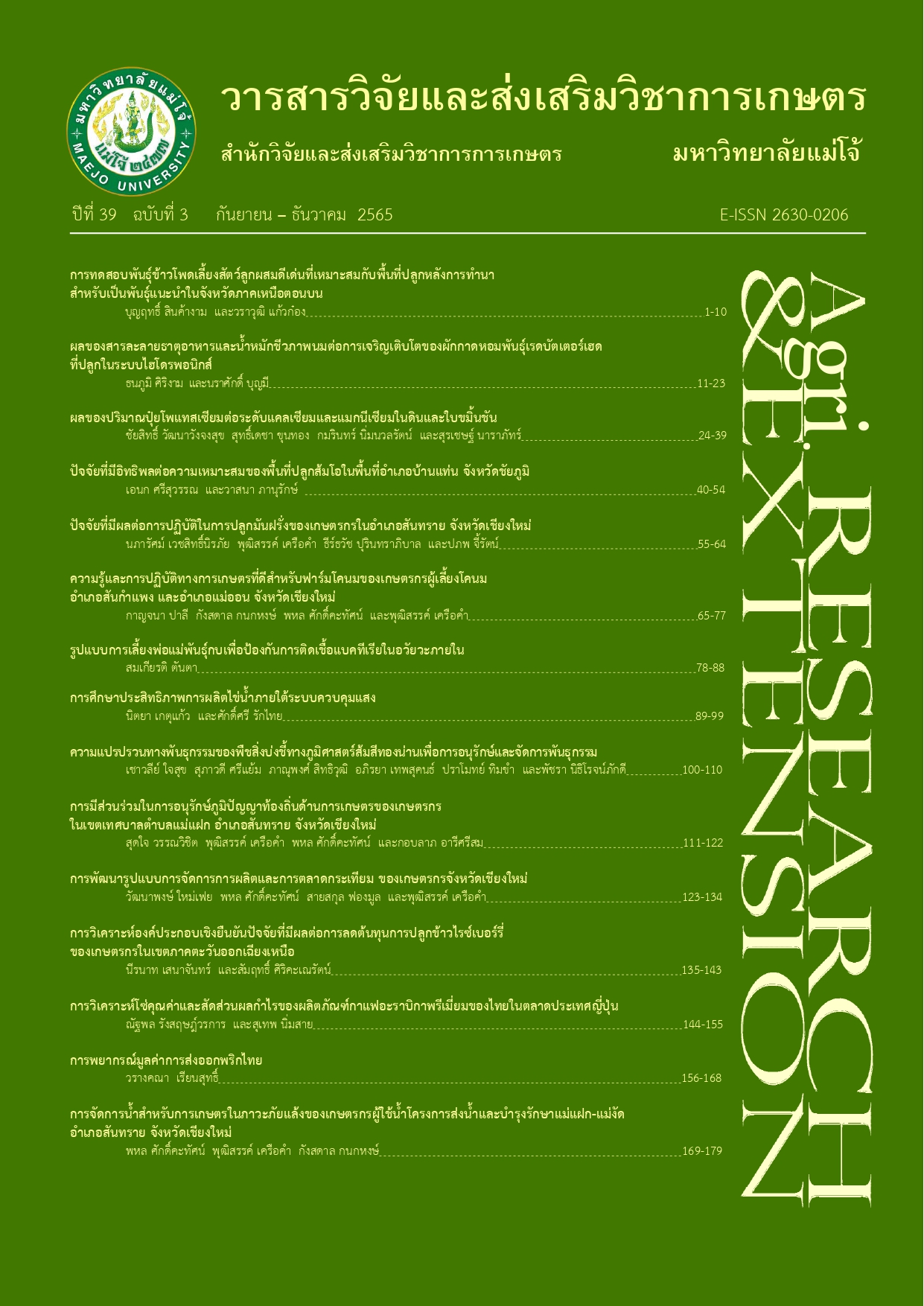การวิเคราะห์องค์ประกอบเชิงยืนยันปัจจัยที่มีผลต่อการลดต้นทุนการปลูกข้าวไรซ์เบอร์รี่ ของเกษตรกรในเขตภาคตะวันออกเฉียงเหนือ
คำสำคัญ:
การวิเคราะห์องค์ประกอบเชิงยืนยัน , ต้นทุนการปลูกข้าว , ข้าวไรซ์เบอร์รี่ , เกษตรกรบทคัดย่อ
การวิจัยนี้มีวัตถุประสงค์เพื่อสำรวจและระบุปัจจัยที่มีผลต่อการลดต้นทุนการปลูกข้าวไรซ์เบอร์รี่ของเกษตรกร ในเขตภาคตะวันออกเฉียงเหนือ กลุ่มตัวอย่าง ที่ศึกษา คือ เกษตรกรที่ปลูกข้าวไรซ์เบอร์รี่ในปีเพาะปลูก พ.ศ. 2560/61 ชนิดข้าวนาปีที่ลงทะเบียนเกษตรกรกับสำนักงานเกษตรจังหวัด ในภาคตะวันออกเฉียงเหนือ สถิติที่ใช้ ได้แก่ การวิเคราะห์องค์ประกอบเชิงสำรวจ และการวิเคราะห์องค์ประกอบเชิงยืนยัน ผลการวิเคราะห์องค์ประกอบเชิงสำรวจสามารถจำแนกองค์ประกอบได้ 5 องค์ประกอบ ประกอบด้วยองค์ประกอบที่ 1 ด้านเตรียมดิน องค์ประกอบที่ 2 ด้านการจัดการน้ำ องค์ประกอบที่ 3 ด้านการใช้ปุ๋ย องค์ประกอบที่ 4 ด้านการเก็บเกี่ยว และองค์ประกอบที่ 5 ด้านการกำจัดวัชพืช นำปัจจัย ทั้งหมดมาทดสอบความสอดคล้องของโมเดลโดยใช้โปรแกรม AMOS วิเคราะห์องค์ประกอบเชิงยืนยันอันดับที่สอง เพื่อยืนยันความสอดคล้องผลการวิเคราะห์องค์ประกอบเชิงสำรวจตามทฤษฎีกับข้อมูลเชิงประจักษ์ และทำการวิเคราะห์หาค่าน้ำหนักความสำคัญของปัจจัย ที่มีผลต่อการลดต้นทุนการปลูกข้าวไรซ์เบอร์รี่ ผลการวิจัยพบว่า โมเดลมีความสอดคล้องกับข้อมูลเชิงประจักษ์เป็นอย่างดีได้ค่า Chi–Square=62.247, P-value=0.081, RMSEA=0.029, GFI=0.981, AGFI=0.939 อย่างมีนัยสำคัญทางสถิติที่ระดับความเชื่อมั่น 0.001 แสดงว่าองค์ประกอบทั้ง 5 ด้าน มีผลต่อการลดต้นทุนการปลูกข้าวไรซ์เบอร์รี่ของเกษตรกรในเขตภาคตะวันออกเฉียงเหนือ โดยมีค่าน้ำหนักปัจจัยเรียงจากมากไปน้อย ดังนี้ ด้านการกำจัดวัชพืช (0.97) ด้านการจัดการน้ำ (0.89) ด้านการใช้ปุ๋ย (0.88) ด้านการเก็บเกี่ยว (0.72) และด้านเมล็ดพันธุ์ข้าว (0.64)
เอกสารอ้างอิง
Chamroensan, N., A. Saenphuwa, A. Siriwetphan and C. Chaitawin. 2016. Rice Farming Wisdoms to Decreasing the Cost of Farming including Increased Productivity of Farmers Organization, Mod-Ngan Saang-Mueang Group Phichit Province. pp. 252-267. In Proceedings of Social Development and Management Strategy, 9 July 2016. Nontaburi: National Institute of Development Administration (NIDA). [in Thai]
Nakhonphanom Provincial Agricultural Extention Office. 2021. Inviting agriculture to grow riceberry rice, very useful rice. [Online]. Available http://www.nakhonphanom.doae.go.th/?p=422 (21 May 2021 ). [in Thai]
Noisopha S. 2015. “Organic agriculture” an opportunity for Thailand to export and set foot in the world market. Journal of Thonburi University 9(18): 83-91. [in Thai]
Pearson, R.H. and D.J. Mundform. 2010. Recommended sample size for conducting exploratory factor analysis on dichotomous data. Journal of Modern Applied Statistical Methods 9(2): 359-368.
Phitsanulok Rice Seed Center. 2011. Reducing the cost of rice production. [Online]. Available http://th-th.fbjs.facebook.com/note.php?note_id=259156740801978. (20 March 2018 ). [in Thai]
Pongklang, P. 2016. Guidelines for management of production costs for rice planting. Kasetsart Applied Business Journal 10(13): 17-26. [in Thai]
Rodjam, C. and R. Mungsing. 2017. A model of cost determination for riceberry rice planting: a case study at Ban Klong Ta Chom, Moo 9, Bang Kurat district, Bang Bua Thong City, Nonthaburi province. Dhonburi Rajabhat University Journal 11(2): 100-114. [in Thai]
Supkasem, W. and S. Srisuwan. 2017. Farmers’ opinion towards rice production technology in community rice centers, Mueang district, Suphanburi province. Agricultural Science Journal 48(1): 118-126. [in Thai]
Thai Rice Exporters Association. 2020. Situation and opportunity to expand the rice market in Hong Kong. [Online]. Available https://www.thairiceexporters.or.th (19 May 2020). [in Thai]
ดาวน์โหลด
เผยแพร่แล้ว
รูปแบบการอ้างอิง
ฉบับ
ประเภทบทความ
สัญญาอนุญาต
ลิขสิทธิ์ (c) 2022 วารสารวิจัยและส่งเสริมวิชาการเกษตร

อนุญาตภายใต้เงื่อนไข Creative Commons Attribution-NonCommercial-NoDerivatives 4.0 International License.
บทความนี้ได้รับการเผยแพร่ภายใต้สัญญาอนุญาต Creative Commons Attribution-NonCommercial-NoDerivatives 4.0 International (CC BY-NC-ND 4.0) ซึ่งอนุญาตให้ผู้อื่นสามารถแชร์บทความได้โดยให้เครดิตผู้เขียนและห้ามนำไปใช้เพื่อการค้าหรือดัดแปลง หากต้องการใช้งานซ้ำในลักษณะอื่น ๆ หรือการเผยแพร่ซ้ำ จำเป็นต้องได้รับอนุญาตจากวารสาร





